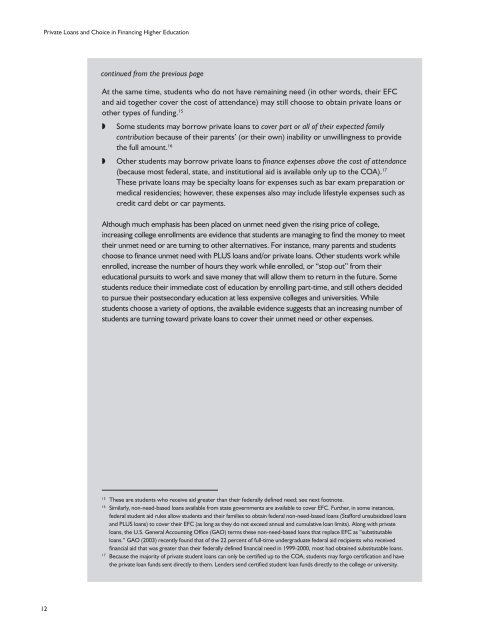Private Loans and Choice in Financing Higher Education - College ...
Private Loans and Choice in Financing Higher Education - College ...
Private Loans and Choice in Financing Higher Education - College ...
You also want an ePaper? Increase the reach of your titles
YUMPU automatically turns print PDFs into web optimized ePapers that Google loves.
<strong>Private</strong> <strong>Loans</strong> <strong>and</strong> <strong>Choice</strong> <strong>in</strong> F<strong>in</strong>anc<strong>in</strong>g <strong>Higher</strong> <strong>Education</strong>cont<strong>in</strong>ued from the previous pageAt the same time, students who do not have rema<strong>in</strong><strong>in</strong>g need (<strong>in</strong> other words, their EFC<strong>and</strong> aid together cover the cost of attendance) may still choose to obta<strong>in</strong> private loans orother types of fund<strong>in</strong>g. 15◗◗Some students may borrow private loans to cover part or all of their expected familycontribution because of their parents’ (or their own) <strong>in</strong>ability or unwill<strong>in</strong>gness to providethe full amount. 16Other students may borrow private loans to f<strong>in</strong>ance expenses above the cost of attendance(because most federal, state, <strong>and</strong> <strong>in</strong>stitutional aid is available only up to the COA). 17These private loans may be specialty loans for expenses such as bar exam preparation ormedical residencies; however, these expenses also may <strong>in</strong>clude lifestyle expenses such ascredit card debt or car payments.Although much emphasis has been placed on unmet need given the ris<strong>in</strong>g price of college,<strong>in</strong>creas<strong>in</strong>g college enrollments are evidence that students are manag<strong>in</strong>g to f<strong>in</strong>d the money to meettheir unmet need or are turn<strong>in</strong>g to other alternatives. For <strong>in</strong>stance, many parents <strong>and</strong> studentschoose to f<strong>in</strong>ance unmet need with PLUS loans <strong>and</strong>/or private loans. Other students work whileenrolled, <strong>in</strong>crease the number of hours they work while enrolled, or “stop out” from theireducational pursuits to work <strong>and</strong> save money that will allow them to return <strong>in</strong> the future. Somestudents reduce their immediate cost of education by enroll<strong>in</strong>g part-time, <strong>and</strong> still others decidedto pursue their postsecondary education at less expensive colleges <strong>and</strong> universities. Whilestudents choose a variety of options, the available evidence suggests that an <strong>in</strong>creas<strong>in</strong>g number ofstudents are turn<strong>in</strong>g toward private loans to cover their unmet need or other expenses.15These are students who receive aid greater than their federally def<strong>in</strong>ed need; see next footnote.16Similarly, non-need-based loans available from state governments are available to cover EFC. Further, <strong>in</strong> some <strong>in</strong>stances,federal student aid rules allow students <strong>and</strong> their families to obta<strong>in</strong> federal non-need-based loans (Stafford unsubsidized loans<strong>and</strong> PLUS loans) to cover their EFC (as long as they do not exceed annual <strong>and</strong> cumulative loan limits). Along with privateloans, the U.S. General Account<strong>in</strong>g Office (GAO) terms these non-need-based loans that replace EFC as “substitutableloans.” GAO (2003) recently found that of the 22 percent of full-time undergraduate federal aid recipients who receivedf<strong>in</strong>ancial aid that was greater than their federally def<strong>in</strong>ed f<strong>in</strong>ancial need <strong>in</strong> 1999-2000, most had obta<strong>in</strong>ed substitutable loans.17Because the majority of private student loans can only be certified up to the COA, students may forgo certification <strong>and</strong> havethe private loan funds sent directly to them. Lenders send certified student loan funds directly to the college or university.12
















